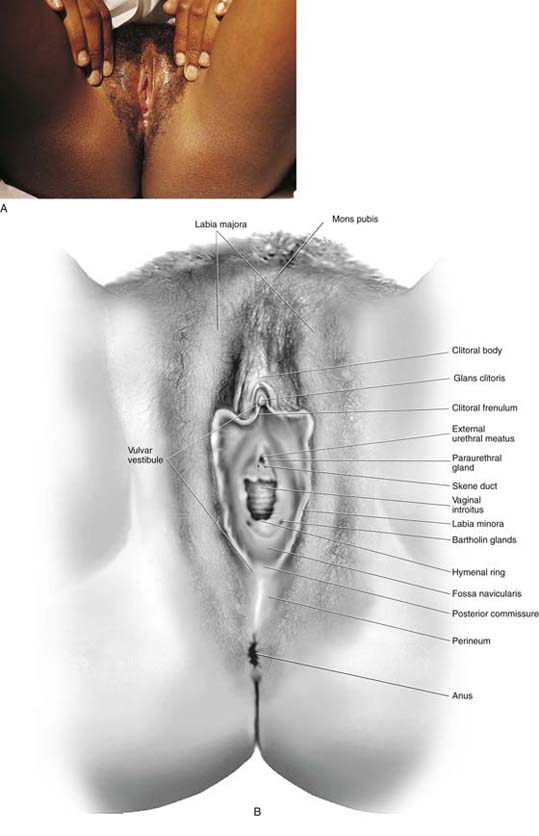Vulvar and Perineal Anatomy
The external genitalia in the female are homologues to structures in the male. The former are unfused, the latter are fused.
The labia majora are homologous to the scrotum; the labia minora, to the median raphe of the penis and scrotum. The glans clitoris, clitoral body, and corpora cavernosa clitoris are direct homologues to equivalent penile structures in the male. The hood of the clitoris and the penile foreskin are likewise of similar origin.
The labia majora consist of skin and appendages, including hair follicles, sebaceous glands, and sweat glands, and create two prominent swellings on either side of the vulva. Subdermal fat deposits produce these bulges (Figs. 64–1A, B and 64–2). The prominence diminishes with age as the fat atrophies. Superficial branches of the pudendal artery supply the labia, and branches of the pudendal, ilioinguinal, genital femoral, and femoral cutaneous nerves supply the neural components (Fig. 64–3A through E).
The labia minora contribute to the structure of the clitoral frenulum and sheath (Fig. 64–4A, B). These structures contain no hair follicles but are copiously supplied with sebaceous glands and sweat glands. The labia are sites for specially adapted large sweat glands, the apocrine glands. These are also present in the perineum and perianal skin.
The area bounded anteriorly by the clitoral frenula, laterally by the medial aspects of the labia minora, and posteriorly by the fossa navicularis and posterior commissure constitutes the vulvar vestibule (see Figs. 64–1B and 64–5A). The external urethral meatus opens into the vestibule, as does the vaginal introitus. The hymenal ring frames the vaginal opening and is considered to be a portion of the vestibule (Fig. 64–5B). Additionally, several mucous glands open into the vestibule [Bartholin (major vestibular), minor vestibular, Skene ducts, paraurethral] (see Figs. 64–1B and 64–5C, D).
Below (caudad to) the external genitalia lies a flattened area extending between the anus and the lower portions of the labia majora and posterior commissure (Fig. 64–6). This region is referred to as the perineum, although the term also may encompass the whole area from the mons to the anus to the medial aspects of the buttocks and junction with the thighs. The perianal skin and anus constitute a part of the perineum and have much in common with the rest of the vulva (Fig. 64–7).
A flap may be cut to expose the underlying anatomy by incising from the top of the mons through the right or left interlabial sulcus to the perineum above the perianal skin. The flap is then cut from medial to lateral and is reflected laterally (Fig. 64–8). Ninety-five percent of the tissue beneath the skin of the labia majora is fat, through which course superficial vessels and nerves (branches of internal pudendal and pudendal) (Fig. 64–9). A membranous condensation of fat is located superficial to the thin muscles of the urogenital diaphragm. This is Colles’ fascia, which may easily be dissected with the fingers upward over the symphysis and above the inguinal ligament to Scarpa’s fascia of the anterior abdominal wall. Just lateral and juxtapositioned to the hymenal ring beneath the vestibular skin is the bulbocavernosus muscle (Fig. 64–10A, B). During actual dissection, the muscle is thinner than depicted in the schematic illustrations shown in most anatomic texts (Fig. 64–11A through C). The same can equally be said for superficial transverse perineal muscle, which extends anterolaterally from its junction with the bulbocavernosus to the ischial tuberosity (Fig. 64–12A, B). Inferior to the latter muscle is the septated and fat-filled ischiorectal fossa. The fossa borders the anus and rectum medially (Fig. 64–13A through F). The levator ani descends through the ischiorectal fossa peripheral to the external sphincter and rectum (Fig. 64–14A through C). The ischiocavernosus muscle lies directly along the superior ischial ramus partly overlying the corpora cavernosa clitoris (crus). In relative size, the crus dwarfs the muscle (Fig. 64–15). A tough membrane encompasses the clitoral crus, the bulb of the vestibule, and the body of the clitoris. The membrane is tightly adherent to the cavernous vascular structures, which constitute the bulb, clitoris, and corpora (Fig. 64–16). The deep perineum is in fact revealed to be a vascular lake, and the most impressive structures in the deep perineum are these cavernous vascular structures. The cavernous structures impart a bluish hue because of the venous blood held within the vascular sinuses (Fig. 64–17A, B). The bulb is closely applied to the lateral aspect of the vaginal wall, which is also honeycombed with large cavernous and venous sinuses. Between the lateral margin of the bulb, the pubic, and the ischial rami is the fascia-muscle complex of the levator ani (Fig. 64–18). Similarly, the urethra is covered by an umbrella-like mass of cavernous tissue emanating from the bulb of the vestibule (Fig. 64–19A, B). The urethra, vagina, and cavernous structures are intimately applied to one another immediately below and at the urethrovesical junction (Fig. 64–20).
The anal opening is below the perineum. The course of the anus/rectum is upward (cephalad), deep to the broad anal sphincter and perineum, to situate itself 3 to 4 mm beneath the fossa navicularis and the lower vagina. The rectum is located in the posterior midline directly beneath the perineum (see Fig. 64–20). The space between the perineal and vestibular skin surfaces and the rectum depends to a great extent on the development, mass, and integrity of the perineal body and the anterior sphincter ani muscle (Fig. 64–21). At the point where the rectum reaches within a few millimeters of the posterior vagina, it parallels the vagina and follows a posterior and cephalad course (Fig. 64–22). The vagina may be freed from the rectum by careful incision and dissection of the rectovaginal septum from below upward, or by entry into the rectouterine space from above.
FIGURE 64–1 A. The labia majora form two prominent swellings that are produced by fat deposits lying between the dermis and Colles’ fascia. These hair-bearing areas are rich in sebaceous glands, hair follicles, and sweat glands. B.








